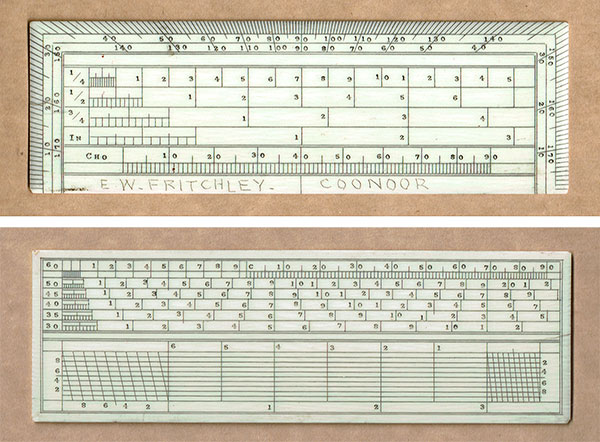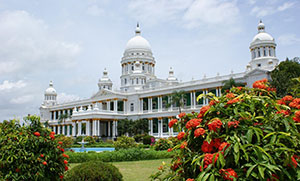 Up
Up
|
|

|

|
Meet E. W. Fritchley |
|
|
|
|
|
|
Slide rules were valuable and cherished
tools, and their owners often marked them with their names or
initials. Many items in my collection are thus identified: I know
that my Hemmi No. 256 Electric Communication Engineer Slide Rule was
the property of Ron Runswick; I know that my Tavernier-Gravet
Chisel-cursored Mannheim rule belonged to R. Humphries; and so on.
Unfortunately, I have no idea who Ron was (though I do have his
street address in Santa Clara, which he wrote on the rule’s leather
case), nor who Mr. Humphries was (but I know that he bought his
slide rule in 1895, which he scratched on its back). I’d love to
know more about who these -- and other -- owners were, and how they
lived; but this remains forever beyond my ken. And here is an exception: a protractor which I found in a flea market in Jerusalem. Not really a slide rule, but it wasn’t expensive and made a good consolation buy -- you know, when you don't find exactly what you want at a market but don't want to go home empty-handed… |
|
|
|
 Click photo to enlarge |
|
|
|
This protractor is a flat, five-inch-long
rectangle of ivory, with 180-degree scales around 3 beveled sides
for measuring angles, and multiple scales for figuring distances in
scaled drawings or maps. This was a common enough instrument in the
hands of architects, surveyors and draftsmen in the 19th century.
And this one has an inscription, scratched in reasonably neat block
capitals: E. W. FRITCHLEY. COONOOR. Out of curiosity I Googled EW Fritchley, and I found that there was in the right country at the right timeframe a British architect called Edwin Wollaston Fritchley. He was based in Bombay (now Mumbai), and he made significant contributions to the architectural landscape of India during the late 19th and early 20th centuries. He combined elements from European and Indian traditions, and has left his mark on a variety of buildings; many consider his most impressive edifice to be the Lalitha Mahal palace, built for the Maharaja of Mysore, which is at present a luxurious hotel (photo below). What I managed to find about Mr. Fritchley’s bio is that he was born about 1860 and died |
|
|
|
in 1927. In between he made India his home, where he married and
had two sons (the older of which was a draftsman at some point). He
was a Fellow of the Royal Institute of British Architects, and a
Fellow of the Royal Geographical Society as well. As for Coonoor, the location named on the protractor -- it is not far from Mysore, as Indian distances go... and it is home to the Stanes Anglo Indian Higher Secondary School, which was founded in 1858. And get this: one of the four Houses of the school (this is a school in the British tradition!) is called Fritchley House. Coincidence? |
 Click photo to enlarge Credit: Ezhuttukari via Wikimedia Commons |
|
|
|
This little protractor has made a long journey in space and time until it landed in my hands in Jerusalem. And now I know who owned it, and what he used it for. How cool is that? I love these things! |
|
|
|
Exhibit provenance: A serendipitous find at a flea market in Jerusalem. |
|
|
|
|
|
|
|
Home | HOC | Fractals | Miscellany | About | Contact Copyright © 2024 N. Zeldes. All rights reserved. |
|